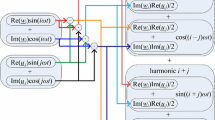Abstract
A new algorithm is presented to reduce computational costs in solving harmonic balance equations obtained by separating state variables. The harmonic balance method is widely used in RF electronics CAD systems. In the author's previous works, an approach was proposed where the vector (matrix) of unknowns is replaced by two matrices of small dimension, which leads to two systems of balance equations that are solved iteratively. The first equation reduces the number of harmonics in the balance equations, the second equation reduces the number of circuit nodes. Equations with reduced dimension are solved sequentially by Newton's method. This algorithm made it possible to reduce computer memory for storing model equations and reduce computational costs when solving high-dimensional problems. In this paper, it is proposed to further reduce computational costs by approximating part of the elements of the balance equations using the decomposition procedure based on singular values. It is proposed to construct a matrix of sets of responses of nonlinear dependencies of circuit models before solving the problem by an iterative method. This matrix reflects all the main changes in nonlinear dependencies with changes in the amplitudes of the input effect and over time. The resulting matrix is then approximated by applying decomposition based on singular values. The matrix of averaged values reduced in this way is substituted into the balance equations. Comparison of the proposed algorithm with the standard harmonic balance method and algorithms developed by the author earlier showed its high efficiency. #CSOC1120.
Access this chapter
Tax calculation will be finalised at checkout
Purchases are for personal use only
Similar content being viewed by others
References
Lantsov, V.: A new algorithm for solving of harmonic balance equations by using the model order reduction method. In: Proceedings of 2020 Ural Symposium on Biomedical Engineering, Radioelectronics and Information Technology (USBEREIT), Ekaterinburg, pp. 295–297 (2020)
Lantsov, V.N.: A new algorithm of solving harmonic balance equations. J. IOP Conf. Ser. Mater. Sci. Eng. 862(5), 05203 (2020)
Lantsov, V., Papulina, A.: Algorithms for software tools with harmonic balance method. In: Proceedings of 2021 IEEE Ural Symposium on Biomedical Engineering, Radioelectronics and Information Technology (USBERREIT), Ekaterinburg, 13–14 May 2021, pp. 228–230 (2021)
Nastov, O., Telichevsky, R., Kundert, K., White, J.: Fundamentals of fast simulation algorithms for simulation algorithms for RF circuits. Proc. IEEE. 95(3), 600–621 (2007)
Carvalho, N.B., Pedro, J.C., Jang, W., Steer, M.B.: Nonlinear RF circuits and systems simulation when driven by several modulated signals. IEEE Trans. MTT 54(2), 572–579 (2006)
Lantsov, V.N.: Order-reduction methods for models of complex electronic circuits (review). Radio Telecommun. Syst. No. 3, 59–65 (2012)
Charumathi, V., Ramakrishna, M., Vasudevan, V.: Fast proper orthogonal decomposition using improved sampling and iterative techniques for singular value decomposition. Cornell University Library. https://arxiv.org/abs/1905.05107 (2019)
Antoulas, A.C., Sorensen, D.C.: Approximation of large-scale dynamical systems: an overview. Int. J. Appl. Math. Comput. Sci. 11(5), 1093–1121 (2001)
Chaturantabut, S., Sorensen, D.C.: Nonlinear model reduction via discrete empirical interpolation. SIAM J. Sci. Comput. 32(5), 2737–2764 (2010)
Kundert, K., White, J., Sangiovanni-Vincentelli, A.: Steady-State Methods for Simulating Analog and Microwave Circuits, p. 455. Klawer Academic Publishers, New York (1990)
Ushida, A., Adachi, T., Chua, l.O.: Steady-state analysis of nonlinear circuits based on hybrid methods. IEEE Trans. CAS-39(8), 649–661 (1992)
Ramalingam, A., Singh, A.K., Nassif, S.R.: Accurate waveform modeling using Singular Value Decomposition with applications to timing analysis. In: Proceedings of IEEE Design Automation Conference, pp. 148–153 (2007)
Bond, B.N., Daniel, L.: A piecewise-linear moment-matching approach to parameterized model-order reduction for highly nonlinear systems. IEEE Trans. Comput.-Aided Des. 26(12), 2116–2129 (2007)
Lantsov, V.N., Dolinina, A.A.: Method of lowering the order of models based on Volterra series. Dyn. Complex Syst. 10(3), 50–54 (2016). (in Russian)
Author information
Authors and Affiliations
Corresponding author
Editor information
Editors and Affiliations
Rights and permissions
Copyright information
© 2022 The Author(s), under exclusive license to Springer Nature Switzerland AG
About this paper
Cite this paper
Lantsov, V. (2022). Approximation of the Jacobian in Solving Harmonic Balance Equations. In: Silhavy, R. (eds) Artificial Intelligence Trends in Systems. CSOC 2022. Lecture Notes in Networks and Systems, vol 502. Springer, Cham. https://doi.org/10.1007/978-3-031-09076-9_56
Download citation
DOI: https://doi.org/10.1007/978-3-031-09076-9_56
Published:
Publisher Name: Springer, Cham
Print ISBN: 978-3-031-09075-2
Online ISBN: 978-3-031-09076-9
eBook Packages: Intelligent Technologies and RoboticsIntelligent Technologies and Robotics (R0)




